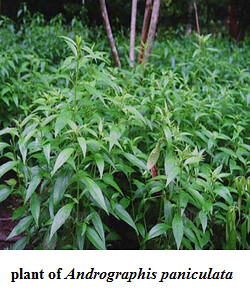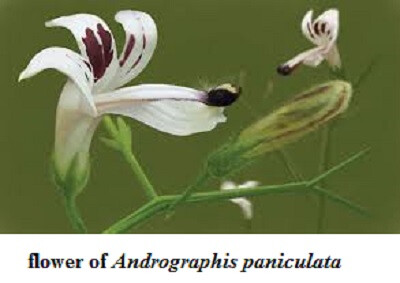Authors: Ramesh Kumar and Dr. R.B. Dubey
Department of Plant Breeding & Genetics, Rajasthan College of Agriculture, Maharana Pratap University of Agriculture & technology, Udaipur, India
Systems of medicine viz., Ayurveda, Siddha, Unani and Homoeopathy already described a lot of plants on the basis of their medicinal prosperities. Plants viz., Andrographis paniculata (Kalmegh), Ocimum sanctum (Tulasi), Ferula assafoetida (Turmeric), Rauwolfia serpentine (Sarpagandha), Asparagus racemosus (Shatavari) and Plantago ovate (Isabgol) are good source of medicines comprising to various groups such as anti oxidant, anti-cancer, antispasmodics, emetics and antimicrobials etc.
Andrographis paniculata (2n=50) also known as 'King of Bitters' is a major source of medicines, which are used extensively as an anti-inflammatory and antipyretic drug for the treatment of fever, cold and laryngitis.
Taxonomic hierarchy of Andrographis paniculata:
- Kingdom: Plantae
- Division: Angiospermae
- Class: Dicotyledoneae
- Order: Tubiflorae
- Family: Acanthaceae
- Genus: Andrographis
- Species: paniculata Nees
Morphology
- Andrographis paniculata is a annual branched herb.
- Inflorescence is paniculate cyme.
Flowers complete, bisexual and self compatible.


Chemical Constituents
Therapeutically active constituents are Andrographolide, 14-Deoxy-11,12-didehydroandrographolide, 14-Deoxyandrographolide, 3,14-Dideoxyandrographolide, 14-Deoxy-11-oxoandrographolide and 14-Deoxy-12-hydroxyandrographolide. These chemical compounds are generally extracted from whole plant parts of Andrographis paniculata.
Medicinal profits
Andrographis paniculata play important role in hepatoprotective activity, immunological bene?ts, anti-in?ammatory activity, respiratory system bene?ts, anti-malarial activity, cardiovascular activity, psycho-pharmacological activity, hypoglycemic activity and anti-fertility activity etc.
The Traditional Uses of Andrographis paniculata[1]
| Native Names | Traditional Uses | |
| Traditional Chinese Medicine | Chuan-Xin-Lian | Fever, Common cold |
| Chunlianqialio | Laryngitis, Pharyngitis, Tonsillitis | |
| Yiqianxi | Pneumonia | |
| Si-Fang-Lian | Respiratory infections | |
| Zhanshejian | Hepatitis | |
| Traditional Indian Medicine | Kalmegh | Diabetes |
| Kiryato | Dysentery, Enteritis | |
| Maha-tikta | Helminth infection | |
| Bhunimba | Herpes Peptic ulcer Skin infections (topical use) Snake-bites (topical use) | |
| Traditional Thai Medicine | Fah Tha Lai | Fever, Common cold |
| Nam Rai Pangpond | Non-infectious diarrhea | |
| Malaysia | Hempedubumi | Diabetes |
| Sambiloto | Hypertension | |
| Japan | Senshinren | Fever, Common cold |
| Scandinavian | Green Chiretta | Fever, Common cold |
Recent research has excitingly indicated that extracts of Andrographis paniculata may have the potential for interfering with the viability of the human immuno-deficiency virus (HIV) and advised that Andrographis paniculata could combine with modern medicines against acquired immuno-deficiency syndromes (AIDS).[2]
Malaria is still a prevalent disease in many tropical and subtropical countries. Andrographis paniculata was found to considerably inhibit the multiplication of Plasmodium berghei.[3]
It is widely used in traditional medicine as an antidote against poisons of snakes and insect, and as an antimalarial agents[4]
It is suggested that due to anti-fertility activities (antispermatogenic or antiandrogenic) of Andrographis paniculata use of this herb during pregnancy should be avoided.
REFERENCES:
[1] Caceres, D. D., Hancke, J. L., Burgos, R. A. and Wikman, G. K. (1997) Prevention of common colds with Andrographis paniculata dried extract: A pilot double-blind trial. Phytomedicine, 4, 101â€"104.
[2] Stephen, H. and Comac, L. (2000) Miracle herbs: How herbs combine with modern medicine to treat cancer, he art disease, AIDS, and more, Kensington Publishing Corporation, New York.
[3] Misra, P., Pal, N. L., Guru, P. Y., Katiyar, J. C., Srivastava, V. and Tandon, J. S. (1992) Antimalarial activity of Andrographis paniculata (Kalmegh) against Plasmodium berghei NK 65 in Mastomys natalensis. International Journal of Pharmacognosy, 30, 263â€"274.
[4]Jain S K & Tarafder C R, Indian Medical Journal, 57, 1963, 307.
About Author / Additional Info:
I am currently pursuing M.Sc. in Plant Breeding and Genetics, Rajasthan College of Agriculture, MPUAT, Udaipur, Rajasthan, India